December 22 - 28, 2013: Issue 142
Yellow Monday Cicadas – The Australian Insect Canary
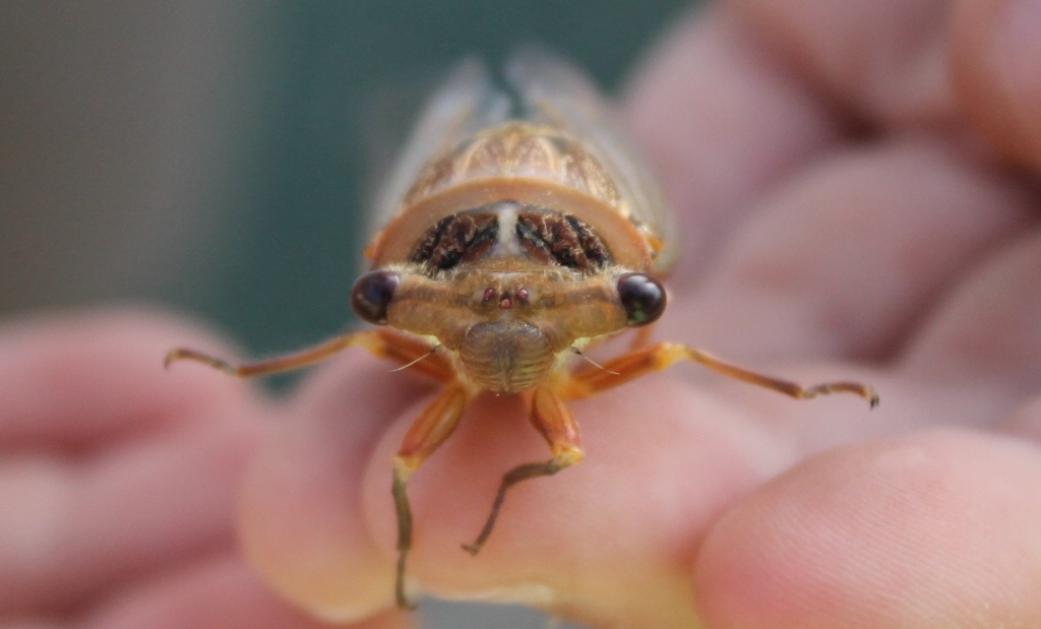
Yellow Monday Cicadas – The Australian Canary
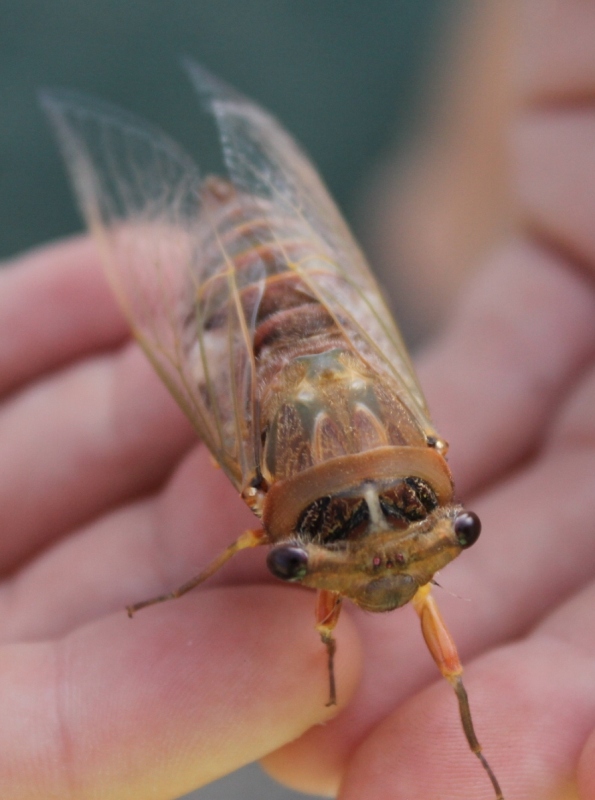 Since at least 1840 and during the Autumn of 1884 our resident cicadas have been described for their song, or noise as some prefer to call. Having sat quietly in the bush listening to their chorus for many an hour what this simple scribe has heard is a symphony that swells and overlaps with one bank of green eucalyptus pausing to swell and then answer an opposite bank of green and cicada song. This is an eternal symphonic orchestra played during Summer that must somehow match the sunbeams in vibrations and refractions of light hat falls silent only during teeming Summer rains, as though these have taken their part on the orchestral Summer stage.
Since at least 1840 and during the Autumn of 1884 our resident cicadas have been described for their song, or noise as some prefer to call. Having sat quietly in the bush listening to their chorus for many an hour what this simple scribe has heard is a symphony that swells and overlaps with one bank of green eucalyptus pausing to swell and then answer an opposite bank of green and cicada song. This is an eternal symphonic orchestra played during Summer that must somehow match the sunbeams in vibrations and refractions of light hat falls silent only during teeming Summer rains, as though these have taken their part on the orchestral Summer stage.
Disappearance of Cicada (Locusts).
A LOCAL contemporary says that the noisy insect generally known as "locust" or "Australian Canary" is being rapidly exterminated, and suggests that the cause is to be found in the English house sparrow pest. We have noticed that during the present summer the terrible song of the locust in the suburbs of Sydney has been unusually absent; but we have frequently observed, in years previous to the insane introduction of the irrepressible bird, similar absence of the handsome but noisy locust during several, not successive, summers. We do not think the sparrow is accountable for the diminished noise, although he does at times annoy the insect and in play destroys some few individuals. We cannot give a reason for the absence or diminished number of "locusts" during occasional summers, but we have observed Summers when not even the song of a solitary cicada was to be heard. During the present summer the song has been much more rare than usual, still it has been heard. Whether the peculiar state of the weather in the spring months of some years affects the number, or there are certain cycles during one year of which the eggs, larvae, or grubs remain dormant under ground, we cannot say, but we incline to the former as the cause of diminished numbers, and the latter of the total absence of the characteristic songster. Disappearance of Cicada (Locusts). (1884, March 8).Australian Town and Country Journal (NSW : 1870 - 1907), p. 19. Retrieved from http://nla.gov.au/nla.news-article71009215
Although we found instructions dated from 1838 on ‘Of the Code of Directions accompanying the., Correspondence between the Trustees of the British Museum and Lord Glenelg. DIRECTIONS FOR COLLECTING ZOOLOGICAL SPECIMENS.’ For collecting and preserving cicadas in Tasmania, it is our children who have been ascribed as the authors of the many names we have for species of cicada in Australia, and rightly so. Who did not turn over rocks when young to dance away from scorpions, or squat over an ants nest to watch that fervid activity? Who does not, still, catch their breath a little at a lilting by butterfly and, as they grow in years, know what the sight of each in time in each season signifies?
Black Princes(Psaltoda plaga), Yellow Mondays, Green Grocers (called ‘Green Monday’ and ‘Green Tuesday’ earlier on, Blue Moons, (Cyclochila australasiae), Cherrynose(Macrotristria angularis), Floury Baker(Abricta curvicosta) Redeye (Psaltoda moerens) and Double Drummers(Thopha saccata) – what wonderful names to describe the colouring and variations as much as perhaps when and where they were first discovered by little hands.
Ancient cicada myths and legends
To the ancient Greeks the cicada symbolised resurrection, rebirth and immortality and is mentioned as being sacred to the ancient Greek sun god Apollo. Homer mentions cicadas in the Iliad around 900 BC and compares the discourse of "sage chiefs exempt from war" to the song of the cicada.
Ancient Greeks and Chinese made a habit of keeping male cicadas in cages for the pleasure of hearing them sing. One Greek ode to the cicada says: "We call you happy, O cicada, because after you have drunk a little dew in the treetops you sing like a queen".
Cicadas also had a powerful effect on artists as they feature on numerous coins both before and after the time of Christ. A number of beautiful gems have also been found from around 300 BC carved in the likeness of the cicada. The cicada's emergence from the earth was a powerful symbol for ancient Romans with members of the nobility taking to wearing a gold brooch featuring a cicada to hold back their hair.
In Taoism the cicada is the symbol of the hsien, or soul, disengaging itself from the body at death. Cicadas also feature in Japanese carvings on small medicine boxes and they are mentioned in ancient Hindu law as long ago as 200 BC in India. (1.)
CICADA TIME.
(BY CANOPUS.)
Cicada time is rapidly approaching, and soon their shrill song will be ringing out from the gums on a sunny day. Children of Australia have conspired to call the cicadas "locust," but it belongs to a totally different order, and is quite a different creature from the grasshoppers and true locusts.
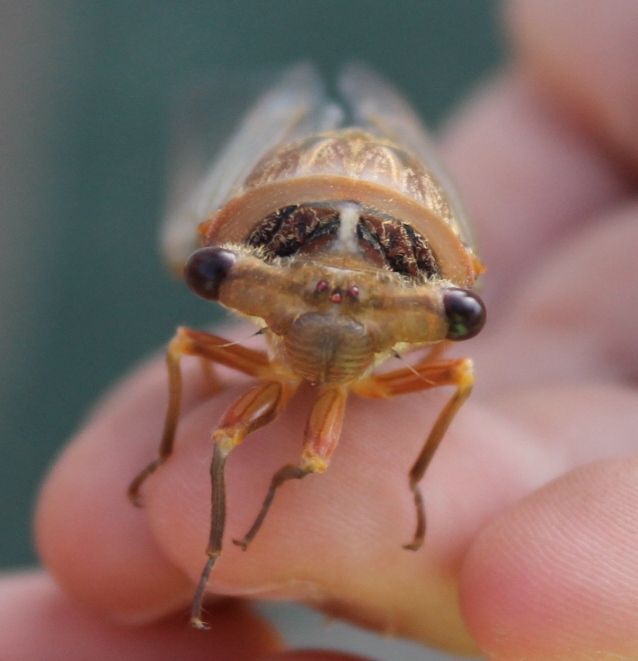 The cicada has a most interesting life history. The eggs are laid by the female during the summer in a thin dry twig. She is provided with a peculiar ovipositor at the end of the abdomen; it is toothed, like a double-edged saw, and is just over a quarter of an inch in length. With this the female punctures tho wood, sawing It until the requisite depth is reached. Then the eggs are deposited. A series of these punctures is made, and as the cicada follows the sun while at her work, the punctures are usually arranged in a spiral track around tho twig.
The cicada has a most interesting life history. The eggs are laid by the female during the summer in a thin dry twig. She is provided with a peculiar ovipositor at the end of the abdomen; it is toothed, like a double-edged saw, and is just over a quarter of an inch in length. With this the female punctures tho wood, sawing It until the requisite depth is reached. Then the eggs are deposited. A series of these punctures is made, and as the cicada follows the sun while at her work, the punctures are usually arranged in a spiral track around tho twig.
When the eggs hatch, which they do in a month or two, according to the weather, the young cicadas are small creatures, somewhat resembling fleas. They drop to the ground, and burrow underneath, staying there until ready to assume their final form. The Australian cicada is supposed to spend about three years underground in this way, but there is one species in America whose subterranean period is supposed to last for no less than 17 years
As an engineer, the cicada is at the head of the profession In the insect world. Its tunnel leads down to the root of a tree, and this supplies It with food and moisture. As the Insect grows its underground chamber is enlarged, and at length it changes to a pupa. At the end of the pupal period it begins to bore upwards to the ground surface, kneading the loose soil which it has dug away into a mud with moisture from its body, and forcing this into the earth at the sides of the tunnel. Thus, when the pupa emerges, the entrance to the tunnel appears as a clean hole, without debris at the sides. These holes are often visible in hard tracks through bush country.
The pupa usually emerges at night, for the fierce sunlight is at first too powerful for eyes long used to the darkness underground. Having left its former home, the insect, still in the pupal condition, slowly makes its way to a neighbouring tree trunk, and climbs up for a short distance When the warmth of the day arrives, the hard skin at the back of the wingless pupa splits, and through the opening the winged cicada slowly draws itself out from its prison. The wings at first are more shapeless, flabby muscles, but after an hour or two they become firm and transparent, and the cicada flies off to enjoy the brief period of life remaining to it.
The song of the cicada is produced from two chambers or soundboxes, one on each side of the body behind the wings. It is only the male insect which sings; the female is silent.
The cicada has for long been looked upon as a typical example of light-hearted idleness. Is there anyone who has not heard the fable of the poor cicada, starving in winter, who begged for food from the industrious ant, and was reproved for not having laid in a store for the cold months. In sober fact, the real position is rather the reverse: in the hot summer, when the ants are unable to obtain moisture from tho ground, they gather around the female cicada as she punctures the trees during her egg-laying, and eagerly sip the drops of sap which ooze from the incisions. And long before the cold of winter arrives the cicada is dead.
It is curious to note that the ancient Greeks kept cicadas in cages, as we do canaries, for the pleasure of listening to their song. CICADA TIME. (1925, November 14). The Sydney Morning Herald (NSW : 1842 - 1954), p. 11. Retrieved from http://nla.gov.au/nla.news-article16254966
THE CICADA.
The air is vibrant with the song of the Cicada. We do not half appreciate this wonderful little creature. He is the chief Instrument In our summer symphony, yet. Like every prophet, he has no honor in his own country. For many years he works underground. For one brief summer he flutters in the sun— If he is lucky enough to escape the evil machinations of the boy. He does no one any harm, carries no germs, does not bite or sting or scratch, yet. because of his little musical legs and wonderful abdominal drum, he is caught and forced to sing out of tune and out of joint.
Certainly he has his little day. Were not the ancient Greeks so attached to cicadas that they used to fasten golden images of them in their hair? Said to live on dew, and addressed by many endearing names. 'the Nightingale of the Nymphs' and 'the Sweet Prophet of the Summer.' Cicadas were favourites of every Grecian bard, from Homer to Theocritus. A Great story tells of two rival musicians contending upon the harp. A cicada, flying to the most artistic, sat upon his instrument, supplied the place of a broken string, and so secured to him the victory. Perhaps the ancient Greek cicadas had gentler voices than ours, or was It the poetical imagination that heard in their song the music of the harp? The Poets of the South of France have the cicadas as their badge, with the motto 'The sun makes me sing.'
Only the male insect can be heard. Isn't he described as the happiest and most Innocent of creatures?
'Happy the cicadas' lives.
Since they all have voiceless wives.'
THE CICADA. (1911, December 2). Evening News (Sydney, NSW : 1869 - 1931), p. 8. Retrieved from http://nla.gov.au/nla.news-article115290845
_________________________________________
A Cicada Story and Poem for Children:
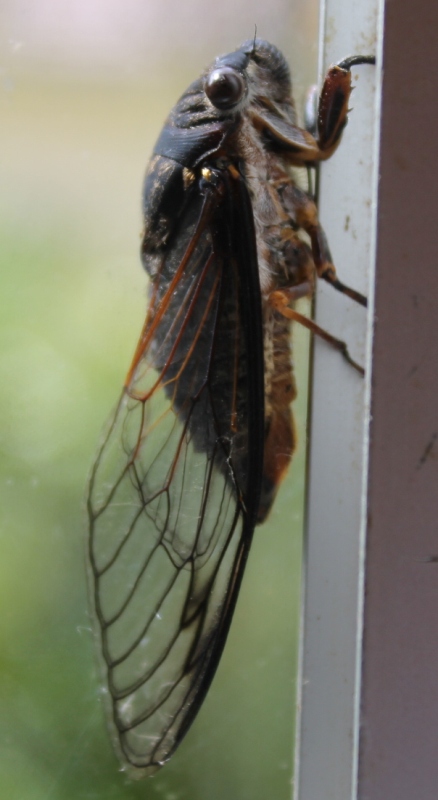 THE CICADA CATCHERS.
THE CICADA CATCHERS.
By Mary Fuller.
(This is a story specially written for the Little People's Page by one of your own. I hope you will like it, and that she will often write another.)
It was early morning in the bushlands, with the sun just peeping through the gum leaves. It was that magic hour, when the indescribable fragrance of Australian plants fills the balmy air, when the breeze is delightfully fresh and invigorating, and when in shady nooks tiny sparkling dew-drops hang on leaf and petal. In such a sheltered nook under a clump of Christmas bush lay Petals and Floret on their moss beds. Mr. Kookaburra suddenly broke into a loud chuckle. Petals and Floret awoke from their slumbers and immediately sprang out of their soft mossy couches.
After bathing in the dew on the grass blades the little fairies put on their best dresses, for they were going .to spend the day with Gum blossom and Honeydew. But as their friends lived high up in Leafy-avenue with the Gumnut babies and the beetles and bees, the two little fairies decided to wait for a 'cicada-bus.' In a few minutes a big cicada flew down to 'them, and Petals and Floret jumped on to his back. He spread his glittering wings, and soon they were speeding through the leaves and blossoms till they arrived at Greysten-street, where the cicada-bus stopped.
They climbed off and ran along to the cluster of blossoms where Gumblossom and Honeydew lived. Presently they were sitting around with Lacewing, Mr. Swallowtail, King Beetle, and many others, who were present as guests. The fairies all sipped nectar and exchanged news, and were spending a very pleasant time with Gum blossom and Honeydew, when suddenly something heavy flew past their branch and fell with a thud on the ground.
'Nearly had him, Tom.'
'Give us another, and I'll try again.'
'No, I'll climb up and get him.'
These were a few of the remarks that floated up to the little fairies who had been so rudely disturbed.
'I wonder who they are, and what they want,' Petals whispered, timidly.
But King Beetle knew.
'They are boys,' he replied.- 'And they want your cicada-bus'.
Gumblossom sent a little flower-beetle to warn the cicada, but he returned in a minute squeaking:
'Oh! there's something big and fat coming up Iron-bark Parade.'
Presently the fairies heard the loud and persistent 'gurk-gurk' of the cicada bus, mingled with the triumphant shouts of Tom.
‘Hooray, Jack, I've got him — a double drummer.'
'Come down and let's see him,' shouted back Jack.
So Tom descended with the cicada-bus in his pocket, and the fairies gathered round again to discuss the strange happenings.
'Oh, dear! There won't be any buses left soon,' said King Beetle. 'Every week the boys come to this valley to catch them, but I've thought of a good plan to punish them now.'
So King Beetle set abut his plan to punish the bad boys. He sent Mr. Swallowtail to tell all the cicadas on the surrounding gums to commence shrilling at once.
'My word, Tom'! Look at that big greengrocer!'
'And here's another brown squeaker!' yelled Tom.
'Oh, bother,' grunted the perspiring Jack after a while. 'Let's have a rest.'
'Righto,' answered Tom. So they sat down on the moss near Petal's and Floret's beds. That was just as the fairies had wanted.
'Come on,' whispered Floret, and they crept nearer to the boys, sprinkling a strong, drowsy perfume, made from scented ti-tree, as they moved.
'It's nice and comfy here,' said Jack.
'Rather,' answered Tom quite drowsily, and before they realised it they were asleep. '
'Right turn,' ordered Commander Bull Ant to his battalion.
'Halt,' as they reached the boy's boots.
'Single file,' and they crawled one by one along their legs.'
'Buzz-buzz,' exclaimed Billy Blue Wasp.
'This way,' as half-a-dozen blue wasps landed on Tom's and Jack's shoulders.
'Szz-z-z,' piped a swarm of mosquitoes as they settled on their coat sleeves.
'Help!' squealed Tom, 'There's ants on my legs!'
'Oh, gee!' roared Jack. 'A wasp's on my neck.'
And the boys jumped round and yelled like mad things.
‘I wonder why they attacked us/’ sighed Tom, but before Jack could suggest a reason a tiny voice piped: 'And I wonder why you took our cicada buses?!’
'What!' Tom began, when Jack chimed in, 'Oh! those locusts!'
'Because everybody has them, and those bush ones squeak awfully well. Who are you, anyway?'
'I'm King Beetle, and these are my subjects. We ride on the cicadas, and how would you like a giant to grab the buses out of your streets?'
'It would be pretty rough,' agreed Tom. 'But we didn't know,' and he transferred the unfortunate cicadas from his pockets to the tree.
Tom and Jack returned home wondering whether it was true or a dream, but they brought no 'double drummers' with them. And they never, went to the bush to catch locusts again, for the simple reason that there were too many bull-ants and wasps there. THE CICADA CATCHERS. (1925, June 25). Freeman's Journal(Sydney, NSW : 1850 - 1932), p. 46. Retrieved from http://nla.gov.au/nla.news-article116792077
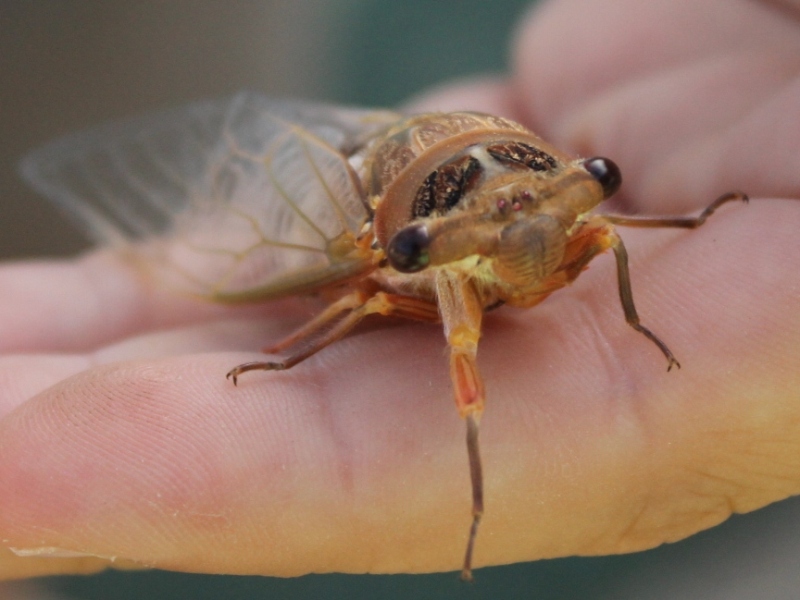
The Children's Page
CONDUCTED BY ERICA
Goody Gossamer's Rhymes.
THE CICADA ORCHESTRA.
When the gum leaves all hang drooping,
And every bird is still,
There comes from each leafy covert,
A droning loud and shrill.
'Zum, zum, zum, I'm a Floury Baker!
Hark to my double-drum;
I can drone by the hour with ceaseless power,
And a zum, zum, zum, zum, zum.'
The hot air seems to quiver
Beneath that steady drone,
And aching heads grow wearier,
With that ceaseless monotone;
"Zum, zum, zum, I'm a real Greengrocer!
Hark to my double drum;
I can make it go for an hour or so,
With a zum, zum, zum, zum."
When the still, hot day is over,
And the west wind drops at length,
The loud cicada chorus Wakens to double strength:
"Zum, zum, zum, I'm a Yellow Monday!
Hark to my double drum;
I can make it drone in its monotone,
With a zum, zum, zum, zum, zum.'
As the slow, slow hours are dragging
Through the hush of a still, hot night;
The full bush band keeps playing,
Right up to the morning light.
"Zum, zum, zum, I'm a Black Prince gorgeous!
Hark to my double drum;
All the long night through I shall play to you,
With a zum, zum, zum, zum, zum."
From the first grey light of the morning,
Till the sun sinks down in the west,
And all through the long night-watches,
The droning knows no rest:
"Zum, zum, zum, I'm a Floury Baker;
Zum, zum, zum, I'm a fat Greengrocer;
Zum, zum, zum, I'm a Yellow Monday;
Zum, zum, zum,
I'm a Black Prince gorgeous.
And each has a double drum.
So with ceaseless tone we just drone, drone, drone,
With a zum, zum, zum, zum, zum."
The Children's Page. (1926, November 18). The Catholic Press(NSW : 1895 - 1942), p. 46. Retrieved from http://nla.gov.au/nla.news-article106276154
References:
1. Owen Craig. Summer of singing cicadas. ABC Science. 17th February, 2001. Retrieved from: http://www.abc.net.au/science/articles/2001/02/17/2822486.htm
CONTINUATION Of the Code of Directions accompanying the Correspondence between the Trustees of the British Museum and Lord Glenelg. (1838, April 13). The Hobart Town Courier(Tas. : 1827 - 1839), p. 4. Retrieved from http://nla.gov.au/nla.news-article4165899
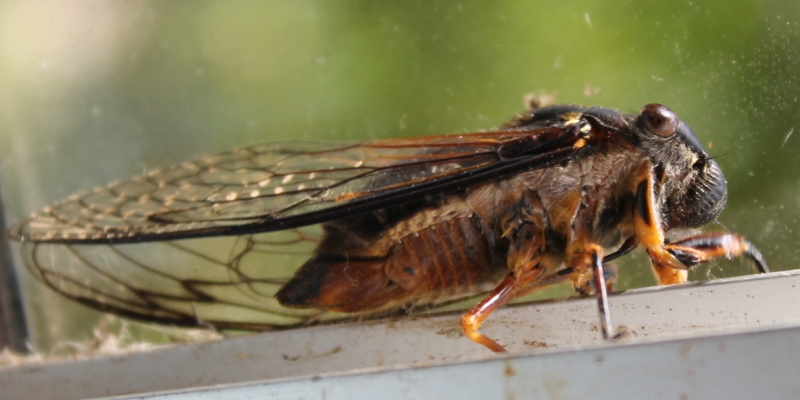
________________________________________
THE NATURAL HISTORY OF THECOLONY.—No. 4.
ENTOMOLOGY. —LEPIDOPTERA. NO. II.
The largest butterfly that the neighbourhood of our city can produce, is, as before states, about the size of the English Vanessa 10; it is seldom seen except at the warmest season of the year, and is at all times scarcer than the Tortoise-shell; it was by far more numerous than I have ever since seen it in December,1839, keeping principally to the Mount Lofty range, where on fine days literally a dozen or more arose at every step of the pedestrian. In the vicinity of the North Para River, about 27miles N.E. of Adelaide, a still larger species at present may be seen, and of more lively and diversified colors, similar in many respects to the English Fritillary butterfly, but on a larger scale; this last mentioned species I believe rather exceeds in size any of our British butter-flies.
Our most beautiful native species of Diurnais by no means rare at some seasons of the year. It is difficult to distinguish it from another native species, from the upper, that is, the side of the winks most frequently presented to view, being very similar, as both are white variously lined or clouded with black. The most common of these two has but little variation in the upper and under sides, the latter having faint yellow spots round the edges of the lower wings, but the under side of the wings. The former are scalloped round with bands of scarlet, and it is in many respects the much smaller in size, very much like the handsome Papilio Egens of New Holland. I will give a farther description of these Diarcae in some future number.
The ones are here more remarkable for their size than their coloring, though many there are professing the latter quality to some extent; the largest I have seen, and which I have now in my possession, measures from tip to tip of the wings, eight inches; the body is about two and two-thirds inches in length, and three-fourths of an inch broad, and the antennae are pectinated; the color is a light brown, and the upper wings are faintly traced with double lines of a darker color, forming large spots or clouds, and presenting a very handsome and regular appearance when closely examined; the wings are thin, but at their base are, like the body, thickly clothed with down. The latest of the British species, is, I believe, the Privet Hawkmoth (Sphinx Ligustri), which measures in the extent of the wings about five and a-half inches, being therefore but little more than two-thirds the size of the one just mentioned.
Another species no doubt of the same family, measures between the extension of the wing tips five and four-fifths inches, the body being half an in inch broad and two inches long; its markings are much handsomer than in the last described species, the lower wings are very similar, but the upper ones have several bands or streaks of a silvery appearance, extending from the base of the wings about half way towards the opposite margin, down which runs a chain of spots of the same silver-like tint; the ground color of the upper wings is rather darker than in the last, but with the same faint waving lines and angles dispersed over their surface; in all other respects this moth resembles the last, with the exception of having the antennae much more strongly pectinated in all those I have found. Both these species vary much in size, but those just described are as large as I have ever seen them. I have, for the sake of a distinguishing English name called the former of these the Goliath and the latter the Achilles moth. I have but little doubt that it is the Chrysalis of the former insect which may be seen in such great numbers in the month of May allover the country, left by its late inhabitant buried in the holes, from beneath which, in this state, it has worked its way, to undergo its final and most surprising change.
The largest of the empty Chrysalides, or cast-off clothing of the liberated moth, is in length four inches, and in breadth at the broadest part not quite an inch, of a find dark polished brown or mahogany color on the upper side as far as the abdomen, each segment of which is divided into three distinct bands by raised lines, the second and third of which are much lighter than the other. Lying near this large Chrysalis may often be discovered, though it is not so common, the deserted tenement, I sup-pose, of the smaller or silver-streaked species, only differing in the length, which is about two-thirds of the other, with proportionate breadth. These different-sized Chrysalides perhaps produce the male and female of the same species, though I should think the two species above described are not so. If these late receptacles of still life are found soon after their tenants have issued from them, they maybe drawn to their full length, displaying distinctly the rings or segments of which they are composed, being mostly left in a crampled upstate by the insect in its efforts to liberate itself. The action of the sun soon turns them to a paler color. One of the commonest of our twilight moths, so often flying into our rooms at sunset, must be well known to all by the large ocelli on the upper wings; this moth is seldom found in a perfect state, as the wings are very thin, and being swift of flight, and, no doubt, as fond of liberty as its companions, on seeing itself con fined its wings are soon torn in its struggles to get free. Short must be its period of enjoyment in each day, for like many of its species, it retires before night quite closes in. That strange infatuation of flying towards the light,(and which has yet not been satisfactorily accounted for) of these insects, that wait for its disappearance to come forth, seems peculiar among the Lepidoptera, almost entirely to the smaller species of Nocturnae.
I am much indebted to a friend for the information that the noisy insects I mentioned in my last are all species of Cicada, which belong to the order Hymenoptera, which was, indeed, a mistake of some consequence. This arose from not having had one in my possession for more than a year, and therefore, speaking of it merely from recollection, the size and notes of this species being the only things I remarked at the time. This insect has for ages been known to the world; it is the fabled lyre of the ancients, and has been often celebrated in song. In Brazil it is remarkable for the almost stunning noise it makes in the trees.
The residence of those organs by which it is able to sound its powerful notes, and which I was unable to discover, are not unknown to naturalists, and are said by Reanmur to be quite internal, and in appearance not unlike to the strings of a harp, producing a similar effect when pulled; the male only possesses the power of song. Their manner of flight alone, if particularly observed, would, in a great measure, distinguish them from the Hymenoptera. On being touched, they launch themselves into the air with the assistance of a spring, as their hind legs are formed for leaping, and their light is then direct, and most like that of the Coleoptera, though slower.
The last mentioned circumstance is rather against their escaping from their foes. I once observed one of the middle sized species met, while on the wing, by a swallow, and as might be expected, instantaneously snapped up, the action not causing the bird to pause, even for a moment, in its rapid flight.
Turn we now to the Orthoptera (grasshoppers, locusts, &c.), an order of insects which here produces astonishing numbers. They are remarkable for the great variety of their forms, and in several of the tribes, for the beauty of their colors, and are generally placed in classification next to the Coleoptera. Under this head are included the various species of grasshoppers, crickets, and other insects similar in make or habits, and which, at a first glance, seem almost innumerable. In this, as in other warm climates, they literally swarm during the summer months, especially in those parts where the long sheltering grass or thick bushes afford them a retreat. Of this order we possess a very large species, which belongs also to one of its principal families, the Phasmidae, some of which are denominated spectre insects. It is certinaly the largest species of this class I ever saw. I obtained possession of it in May 1839; it was a female, and quite perfect, and was caught by a man (from whom I purchased it) with his hand, while flying in the Park Lands near Adelaide.
From the full notes I made at the time on the color and different parts of this extraordinary insect, I will give a description of the size and shape of the principal members. The length of the entire insect from the top of the small, round, and exposed head, which principally denotes the family, to the end of the body, is exactly six inches, and is comparatively narrow, being, at the broadest part, the base or commencement of the abdomen, but six and a half tenths of an inch; the head is four tenths, and the eyes one tenth of an inch in length; the latter are oval, and of a light grey color; the antennae are short, seven tenths of an inch, and composed of twenty-four segments or divisions. The wing covers, (tegmina), which but partially cover the wings, are one and four-fifths inches long, and six tenths of an inch in breadth, in shape like a broad leaf.
The under, or true wings, are rather more than four inches in length, and the outer parts of these, which meet down the abdomen when the insect is at rest, and quite cover the subjoined or gauze like parts, are coriaceous, like the wing covers, and of the same color. The two fore-most legs, which are a little longer than the others, are three and three-tenths inches long, very thin, and nearly the same through their whole length, but the four others have the femur remarkebly flat, smooth, and broad, viz; about three and a half tenths of an inch. With regard to this peculiarity in the last mentioned joint, it does not seem to appertain in particular to any of the legs of these insects, even in this family alone; the color of the whole of the upper side of the body, with the wings, and wing covers, is a dull green, like a partially withered gum tree leaf, and the under side and legs are somewhat paler, the under parts of the tegmina are a pale rose pink, as also all of the wings concealed by them.
This Insect which I before said was a female, laid two eggs soon after I obtained it; they were of the same color and oval shape as its eyes, and also like them, highly polished, butlarger, being less in size than the seed of the sweet garden pea. I have been thus particular in the description of the principal parts of this curious specimen of insect life, both on account of its large size and of its being a member of a family but little seen except between the tropics. The unobtrusive color given by Providence to this species, as well as to many other Orthopterous insects of its tribe, no doubt for its defence and protection from its watchful and quick-sighted feathered enemies, displays in a wonderful manner the Almighty's care of all his creatures, however humble their condition. The above species, when motionless on the trees, in which state many of the Phasmidaeremain for long periods, is exactly the color of the foliage around it. One other species of this insect I have since seen in possession of a gentleman in Adelaide, rather different in color and much smaller in size. Another remarkable insect, which this country also produces, is the Preying Mantis of the South of Europe, which I will describe in my next.
Naturae Amator
December 29th, 1840.
THE NATURAL HISTORY OF THE COLONY.—No. 4. (1841, January 2). South Australian Register (Adelaide, SA : 1839 - 1900), p. 4. Retrieved from http://nla.gov.au/nla.news-article27442150
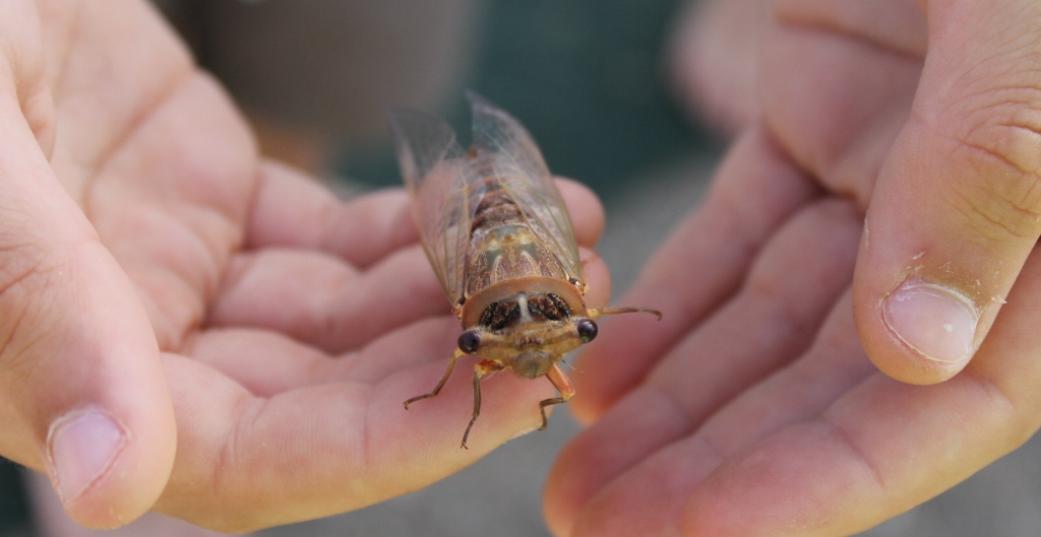
Yellow Monday Cicada
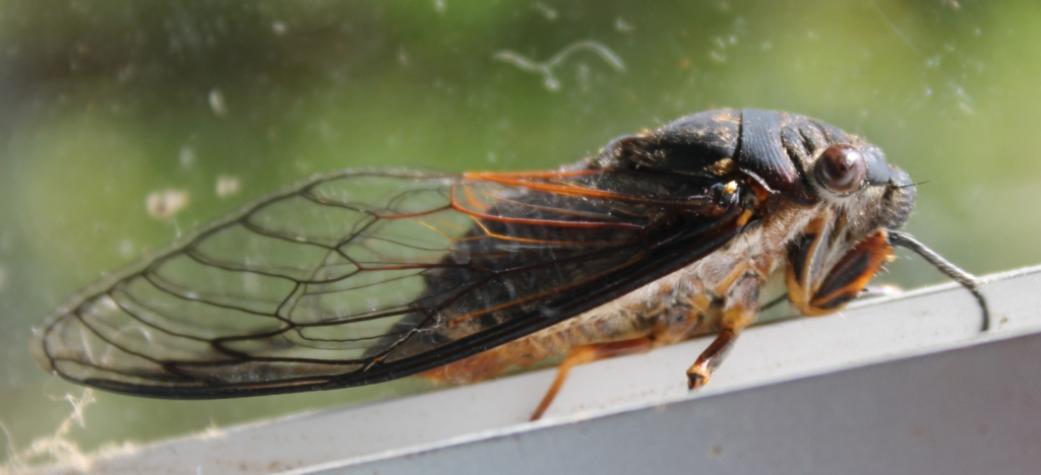
Black Prince Cicada
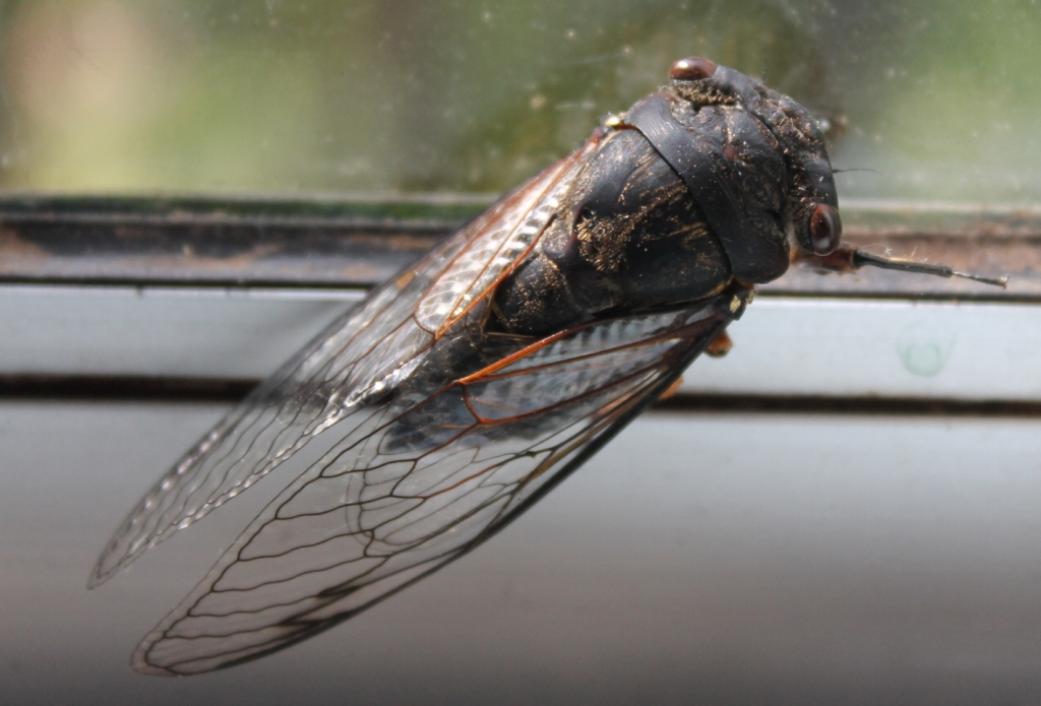
Yellow Monday Cicada - The Australian Canary - with thanks to the little boy who showed us his cicada. Words collected and collated and Pictures by A J Guesdon, 2013.